
Tel: 01482 849205
07870 662358
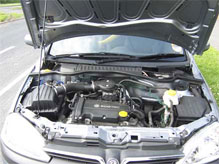 The “Show me, Tell me ” element of the driving test was introduced in Sept 2003. At the beginning of the practical test you will be asked 2 questions. If either or both of these questions are answered incorrectly a minor fault will be marked on the examiners marking paper.
The “Show me, Tell me ” element of the driving test was introduced in Sept 2003. At the beginning of the practical test you will be asked 2 questions. If either or both of these questions are answered incorrectly a minor fault will be marked on the examiners marking paper.
You will be asked to either show or explain how to do some simple maintenance tasks. The following are examples of some safety check questions taken from the DSA (Driving Standards Agency web site):
Open the bonnet, identify
- where you would check the engine oil level and tell me how you would check that the engine has sufficient oil.
- where you would check the engine coolant level and tell me how you would check that the engine has the correct level.
- where the windscreen washer reservoir is and tell me how you would check the windscreen washer level.
- where the brake fluid reservoir is and tell me how you would check that you have a safe level of hydraulic brake fluid.
Tell me how you would check that the
- brake lights are working on this car.
- brakes are working before starting a journey.
- tyres to ensure that they have sufficient tread depth and that their general condition is safe to use on the road.
- the power assisted steering is working before starting a journey.
Show me how you would check the
- headlights & tail lights are working.
- direction indicators are working.
- handbrake for excessive wear.
Question:
- Show me how you would check that the headlights & taillights are working.
Answer:
- Operate switch (turn on ignition if necessary), walk round vehicle.
- HEADLIGHTS Put the headlights on dipped beam. Both should shine with equal brightness — failure to do so means a bad electrical supply or earth at that bulb.
- The reflection from the lights on a wall or garage door should show the two beams pointing slightly down to the left and level.
- There are adjusting screws or knobs behind each headlight, but unless a beam is so far out of line as to cause a hazard, it is probably best to leave adjustment to the MOT tester, who will usually use a beam-setter to set them spot on.
- Switch to main beam and make the same check.
Go here to see about other lighting checks you should make part of your maintenance routine.
[Introduction][Oil level][Coolant level][Windscreen Washer Fluid][Brake Fluid][Brake lights]
[Brakes][Tyres][Steering][Head & Tail lights][Indicators][Handbrake]
Checking the Engine Oil.
The examiner will say something like:
Please open the bonnet, identify where you would check the engine oil level and tell me how you would check that the engine has sufficient oil.
The examiner will expect you to be able to identify the dipstick, describe how to check the oil level against the minimum/maximum marks on the dipstick.
This would be a complete answer:
The vehicle should be parked on level ground and should be secured using the handbrake.
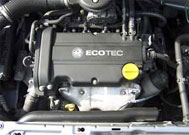 The engine should have been brought to operating temperature and then switched off before waiting a few minutes for the oil to drain back into the reservoir.
The engine should have been brought to operating temperature and then switched off before waiting a few minutes for the oil to drain back into the reservoir.
The dipstick should be taken out - wiped clean with a dry cloth and replaced.
Then remove the dipstick and check where the oil level mark is relative to the H and L marks on the dipstick.
I f the oil level is low it should be topped up (taking care not to
f the oil level is low it should be topped up (taking care not to
overfill) using the correct grade of oil (as indicated in the vehicle handbook).
Use the same procedure to check the level again to ensure it is correct.
[Introduction][Oil level][Coolant level][Windscreen Washer Fluid][Brake Fluid][Brake lights]
[Brakes][Tyres][Steering][Head & Tail lights][Indicators][Handbrake]
Checking the Coolant levels.
The examiner will say something like:
Please open the bonnet, identify where you would check the engine coolant level and tell me how you would check that the engine has the correct level .
The examiner will expect you to be able to identify the high and low level markings on header tank, and describe how to top up to correct level.
This would be a complete answer:
 Identify high/low level markings on header tank where fitted or radiator filler cap, and describe how to top up to correct level.
Identify high/low level markings on header tank where fitted or radiator filler cap, and describe how to top up to correct level.
Caution! Never remove the radiator cap when the engine is hot. Serious scalding could be caused by hot fluid under high pressure escaping from the radiator. Wait until the engine and radiator cool down.
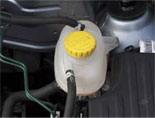 Check the coolant level in the reservoir tank when the engine is cold. If the coolant level is below the "MIN", add coolant up to the "MAX" level.
Check the coolant level in the reservoir tank when the engine is cold. If the coolant level is below the "MIN", add coolant up to the "MAX" level.
If the reservoir tank is empty, check the coolant level in the radiator When the engine is cold. If coolant level is not at the top of the radiator, fill with undiluted coolant up to the filler opening and also add it to the reservoir tank up to the "MAX" level.
Some older vehicles do not have a coolant reservoir tank. If this is the case for your vehicle, then just remove the radiator cap and check the coolant is up to the filler opening.
That's it. The coolant level has been checked.
[Introduction][Oil level][Coolant level][Windscreen Washer Fluid][Brake Fluid][Brake lights]
[Brakes][Tyres][Steering][Head & Tail lights][Indicators][Handbrake]
Checking the Windscreen Washer Fluid.
The examiner will say something like:
Identify where the windscreen washer reservoir is and tell me how you would check the windscreen washer level.
 Flip the tab on the top of the reservoir open. Fill the bottle to the neck using windscreen washer fluid or water.
Flip the tab on the top of the reservoir open. Fill the bottle to the neck using windscreen washer fluid or water.
During winter months water is likely to freeze so make sure 50% windscreen washer fluid is added.
BE CAREFUL NOT TO USE ANTI-FREEZE
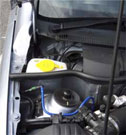
[Introduction][Oil level][Coolant level][Windscreen Washer Fluid][Brake Fluid][Brake lights]
[Brakes][Tyres][Steering][Head & Tail lights][Indicators][Handbrake]

The brake fluid reservoir can't be seen from where you'll stand to open the bonnet -it's hidden below a plastic cover. To check it
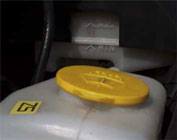 Walk round to the offside and look behind the windscreen washer reservoir. The brake fluid reservoir is under the plastic cover.
Walk round to the offside and look behind the windscreen washer reservoir. The brake fluid reservoir is under the plastic cover.
Check the fluid in the reservoir. If the fluid is below the "MIN" level or the brake warning light comes on, add brake fluid up to the "MAX" line.
Care must be used to ensure that too much fluid isn't used and only the type of fluid recommended in the vehicle handbook should be used.
If the fluid is added frequently, the system should be thoroughly checked by a competent mechanic because the system may have developed a leak.
[Introduction][Oil level][Coolant level][Windscreen Washer Fluid][Brake Fluid][Brake lights]
[Brakes][Tyres][Steering][Head & Tail lights][Indicators][Handbrake]
If the examiner asks ...........
Tell me how you would check that the brake lights are working on this car.
Your answer should be ............
Turn the ignition on.
Operate brake pedal, make use of reflections in windows, garage doors, etc, or
Get a helper to operate the foot brake while you check the brake lights.
Both brake lights must be equally bright, with nothing else glowing.
Switch off the ignition.
[Introduction][Oil level][Coolant level][Windscreen Washer Fluid][Brake Fluid][Brake lights]
[Brakes][Tyres][Steering][Head & Tail lights][Indicators][Handbrake]
The examiner will ask:
Tell me how you would check that the brakes are working before starting a journey.
Answer:
Brakes should be tested as you set off.
Brakes should not feel spongy or slack.
Vehicle should not pull to one side.
Go to the Tips & Tricks page for more information about the brakes
[Introduction][Oil level][Coolant level][Windscreen Washer Fluid][Brake Fluid][Brake lights]
[Brakes][Tyres][Steering][Head & Tail lights][Indicators][Handbrake]
How to Check the Tyres.
Question:
- Tell me where you would find the information for the recommended tyre pressures for this car and how tyre pressures should be checked.
Answer:
- Check the Manufacturer's guide to find the correct pressures to be maintained.
- Use a reliable pressure gauge.
- Check and adjust pressures when tyres are cold.
- Don't forget spare tyre.
- Remember to refit valve caps.
Question:
- Tell me how you would check the tyres to ensure that they have sufficient tread depth and that their general condition is safe to use on the road.
Answer:
- No cuts and bulges
- 1.6mm of tread depth across the central ¾ of the breadth of the tyre and around the entire outer circumference.
Go to the Tips & Tricks page for more about tyres and their maintenance
Want to know how to change one of the tyres if you have a puncture?
[Introduction][Oil level][Coolant level][Windscreen Washer Fluid][Brake Fluid][Brake lights]
[Brakes][Tyres][Steering][Head & Tail lights][Indicators][Handbrake]
Checking the Direction Indicators.
Question:
- Show me how you would check that the direction indicators are working.
Answer: Applying the indicators or hazard warning switch and check functioning of all indicators.
- DIRECTION INDICATORS
Turn the ignition on and operate the indicators. Check that there is a flashing 'tell tale' light on the instrument panel. Check that front and rear indicators are flashing. - The flash rate should be between 30 and 90 per minute. If it's just under 30 it may speed up once the engine is running, though not if the flasher unit is an electronic rather than a mechanical unit. Side repeater indicators on the wings must be working if fitted.
- HAZARD WARNING LIGHTS
With the indicators off, switch on the hazard flashers, checking for the warning light and/or tick inside. Walk round the car to ensure that all four hazards are flashing, and that no other lights are glowing dimly. Switch off hazard flashers.
[Introduction][Oil level][Coolant level][Windscreen Washer Fluid][Brake Fluid][Brake lights]
[Brakes][Tyres][Steering][Head & Tail lights][Indicators][Handbrake]
Question:
• Show me / explain how you would check that the power assisted steering is working before starting a journey:
Answer:
- If the steering becomes heavy the system may not be working properly.
- Before starting a journey two simple checks can be made.
- Gentle pressure on the steering wheel, maintained while the engine is started, should result in a slight but noticeable movement as the system begins to operate.
- Alternatively turning the steering wheel just after moving off will give an immediate indication that the power assistance is functioning.
[Introduction][Oil level][Coolant level][Windscreen Washer Fluid][Brake Fluid][Brake lights]
[Brakes][Tyres][Steering][Head & Tail lights][Indicators][Handbrake]
Checking the Handbrake.
Question:
- Show me how you would check the parking brake for excessive wear.
Answer:
- Demonstrate by applying parking brake that when it is fully applied it secures itself, and is not at the end of the working travel.
- Usually, you can feel if the handbrake needs adjusting if the lever travel is very high.
Any adjustments to the handbrake should be made by a qualified mechanic.
[Introduction][Oil level][Coolant level][Windscreen Washer Fluid][Brake Fluid][Brake lights]
[Brakes][Tyres][Steering][Head & Tail lights][Indicators][Handbrake]
New penalties announced for drivers caught using mob telephones in their cars - see the latest news page.
Driving test fees going up - check the news page for more.
Revised Crossroads tutorial now up and running - check it out now!
|
